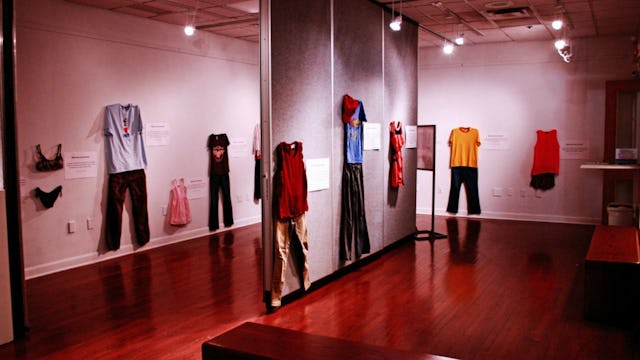'What Were You Wearing?' Exhibit Proves Victim Blaming Is Bullsh*t

Red leggings and a white T-shirt. That’s what I wore the night I was raped. It was 1985, and I was 15 years old.
You may be trying to picture what my outfit looked like. Were my leggings tight? Was my T-shirt cropped? Was my cleavage showing? Did it have a suggestive slogan?
Does it matter?
No. It does not.
When assessing a sexual assault, the only question that matters is whether there was consent. But rape culture (the normalization of sexual violence) has caused people to believe that what a victim wears does matter. Because of rape culture, when trying to figure out why a rape occurred, the obvious answer — because the attacker is a rapist — is often overlooked. Instead, what the victim wore, consumed, said, and how they acted is questioned and scrutinized.
Classic victim blaming bullshit.
A new exhibition at the University of Kansas provides clear evidence to dispel the myth that clothing can provoke a sexual assault. “What Were You Wearing?” displays 18 outfits worn by people during sexual assaults, along with a brief narrative from each of the survivors.
The outfits are part of an installment by the university’s Sexual Assault Prevention and Education Center and curated from the stories of university students. The exhibit is powerful testimony to the fact that clothing worn by a sexual assault victim is completely irrelevant to why they were attacked.
A T-shirt and jeans. Khakis and a dress shirt. A dress. A bathing suit. A child’s dress. Each silently answers the same question, and each begs patrons to see that no matter how much skin the clothing covered, the result was the same.
Too often, those victims brave enough to report sexual crimes committed against them are asked “What were you wearing?” It appears to be a question reserved for crimes against women, as emphasized by a male participant in the University of Kansas exhibit who pointed out that no one he had told about his assault ever asked what he was wearing.
We need exhibits like this now, because although an American is sexually assaulted every 98 seconds, only 1 in 3 sexual assaults are reported. The cycle of victim-blaming starts when victims are interrogated about their clothing, their alcohol consumption and their sexual history, taking the focus away from the only cause of rape: rapists.
Victims begin to question themselves (“Did I do something to cause this?”) and with that questioning comes shame. With that shame, fewer victims report sexual assaults and suffer alone, which leads to less rapists being brought to justice. All this blaming and questioning of victims simply feeds rape culture.
There’s no set of qualifiers for categorizing an act as a sexual assault other than lack of consent. We cannot condone conversations where a victim is scrutinized: “Oh, you were sober, wearing baggy clothing, and assaulted while walking to church? Yes, then we can call that rape. You are officially a victim.” That’s not how it works.
It’s no wonder this culture exists when we have a president who not only bragged about sexually assaulting women, but who also denied that he could have sexually assaulted a journalist, as he deemed her unattractive. He’s the same man who denied sexually assaulting another woman, saying she wouldn’t be his “first choice.” With these statements (and others), Donald Trump told the world that he believes sexual assault is linked to a person’s physical appearance.
How pervasive is the problem? Consider that Chrissie Hynde, lead singer of The Pretenders, wrote in her autobiography that she took full responsibility for her own rape, and that if a woman is walking around in her underwear and drunk, it’s her own fault if she’s raped. No, Ms. Hynde, you’ve fallen prey to rape culture. Sexual violence is not mitigated by your clothing, or lack thereof, your alcohol intake, or the number of people you have slept with prior. Full stop.
Society needs to recognize that the only question to ask a victim of sexual assault is “What can I do to help?” Asking a victim what they wore when they were attacked is irrelevant, damaging, and ignorant. Exhibits like “What Were You Wearing?” help eliminate the notion that a victim is in any way responsible for their attack. Removing blame and shame from the dialogue will empower victims to report their attacks and begin their recovery, without shame or fear.